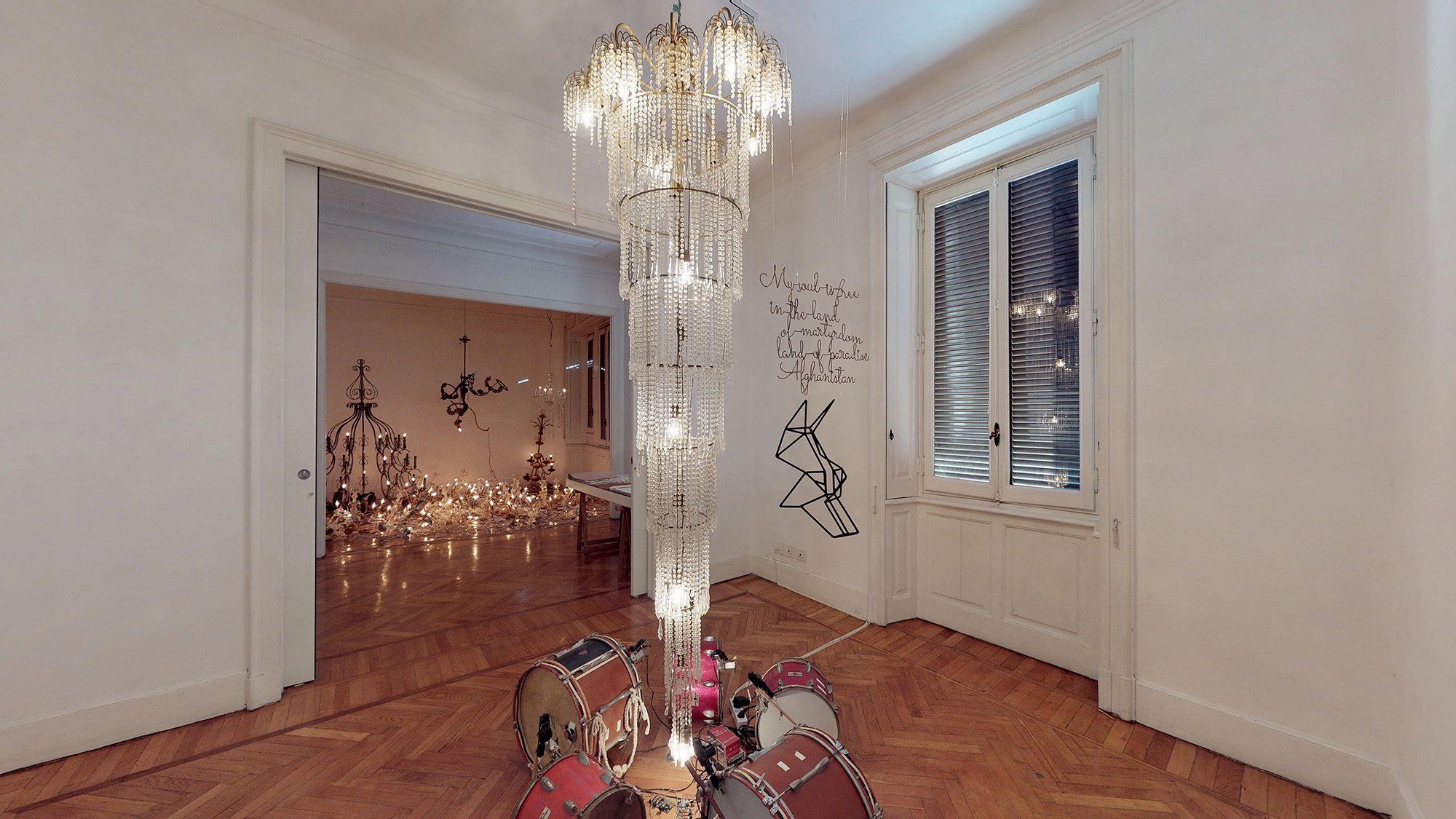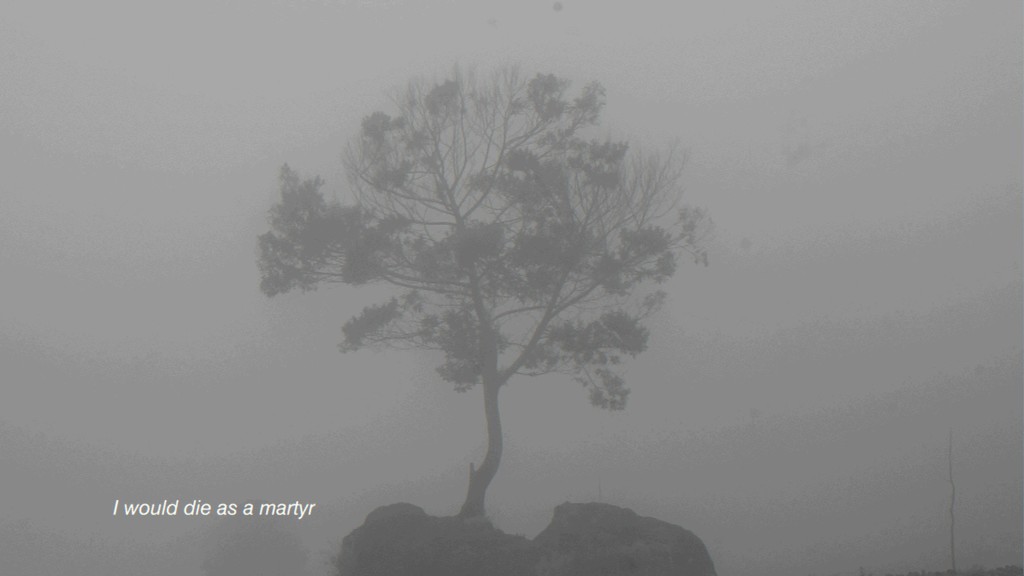Jompet Kuswidananto’s “On Paradise”
By Alessandra Alliata Nobili

Installation view of JOMPET KUSWIDANANTO’s "On Paradise" at aA29 Project Room, Milan, 2019. All photos by Artland.com; courtesy the artist and aA29 Project Room.
Since 1998, Indonesian artist and theatrical performer Jompet Kuswidananto has been working with Yogyakarta-based Teater Garasi, an interdisciplinary performing arts collective exploring Java’s sociopolitical realities through creative expression. Kuswidananto’s personal artistic practice is similarly infused with a theatricality and political bent, combining visual and audio techniques to highlight the ways in which Java’s syncretic cultural and religious heritage, as well as the legacy of colonialism, have left deep marks that reverberate in contemporary society. At his first solo exhibition in Italy, titled “On Paradise” and staged at Milan’s aA29 Project Room, the artist investigated the intertwining of politics and religion in 19th century Java via drawings, video and installation.
The show’s narrative unfolded through a series of works inviting viewers to pull together fragments of interlaced stories. In the show’s centerpiece, On Paradise (2017), crystal chandeliers are suspended precariously from the ceiling or lie shattered on the floor, as if in the aftermath of a cataclysmic earthquake. The installation draws inspiration from the 1888 peasants’ revolt against the Dutch colonial authorities in the region of Banten, western Java. Occurring at a time of natural calamities, such as Krakatoa’s volcanic eruption and an anthrax plague, the violent episode was stoked by local Indonesian political and religious figures who framed the apocalyptic events as a consequence of colonial domination. The shattering of opulent chandeliers—bourgeois emblems of status—symbolizes the rebels’ attack on the powerful colonial aristocracy from whose prosperity they were excluded.

Installation view of JOMPET KUSWIDANANTO’s On Paradise, 2017, chandeliers, broken glass, dimensions variable, at "On Paradise" at aA29 Project Room, Milan, 2019.
Nearby, On Paradise (Drums) (2017) comprises an intact crystal chandelier hanging over a circular arrangement of five vintage-looking drums—referencing the percussive beat of colonial-era military parades—that are sporadically played via a kinetic mechanism. An old radio installed on the floor simultaneously plays crackling sounds, filling the gallery with startling, sudden bursts of noise. Affixed to the chandelier is iron cursive text that spells, “My soul is free / in the land of martyrdom / land of paradise / Afghanistan.” The lyrics were taken from a song describing heavenly redemption through holy war that was written by Imam Samudra, the Indonesian foreign fighter who masterminded the 2002 Bali bomb attack. Hanging beneath the text is a wolf mask, summoning up the figure of the “lone-wolf” terrorist. In dialogue, these two Paradise works draw parallels between a historical, blood-soaked, anti-colonial revolt and the present “culture wars” arising from fundamentalist Islamist terrorism.

Installation view of JOMPET KUSWIDANANTO
More context on the events in Banten was provided by a pair of large albums featuring lithography illustrations and text on craft paper. Sundra Straits Miracle 1850–1888 (2017) describes the natural disasters preceding the revolt. Ominous visions of people wrapped in flames or crushed by giant snakes’ coils take inspiration from a text attributed to the 12th century soothsayer king Jayabaya, whose prophecies were used centuries later by Islamic religious leaders to incite a holy war against the Dutch infidels. In Sundra Straits and Beyond 1888 (2017), the artist fuses history and fiction, imagining that Wasid, the leader of the Banten rebels, was the grandfather of Imam Samudra. Like a dystopian family album, illustrations of Banten riots are interspersed with depictions of foreign fighters undergoing military training and the aftermath of the Bali bombing attack, indicating a haunting echo between events that occurred more than a hundred years apart.

Still image from JOMPET KUSWIDANANTO
The entwining of religion and radicalism surfaced again in the video On Love (2017), presented on a computer screen. Sequences of melancholic, misty landscapes are accompanied by the humdrum chant of a male voice. The chant is based on the same song by Imam Samudra that is referenced in On Paradise (Drums). Alternating and overlapping with this track is a female voice singing of attaining enlightenment and paradise through love. While the songs’ lyrics slowly flow on the monitor as in a karaoke video, the viewer is left to ponder how clashing spiritual views can chart the course of history.
Drawing together diverse stories and metaphors, which are at times difficult to untangle without contextual information, “On Paradise” was nevertheless rewarding to those willing to approach Kuswidananto’s richly layered, research-based practice with patience. A thoughtful and quiet exhibition, the show explored the mingling of spiritual, religious and political instances that have shaped Java’s history and delivered a poignant reflection on the global consequences of local histories, even those considered marginal.
Jompet Kuswidananto’s “On Paradise” is on view at aA29, Milan, until April 7, 2019.







